Brian Fies's Blog
November 18, 2025
250 Words on Double-Deckers

[I try to start my day writing 250 words on anything. I’ll post one every Tuesday until I run out of good ones.]
I’ve had good and bad jobs, but the one that always makes me smile is a job I had in college: driving double-decker buses.
The University of California, Davis, had (and still has) a student-run bus system called Unitrans. It was centered on campus but served the entire city. What made Unitrans unique was its fleet of authentic 1950s red double-decker London buses.
They were finicky beasts: hard to learn but rewarding to master, each with its own personality. Drivers sat up front in a separate cab—naturally on the wrong side of the vehicle, but that wasn’t the tricky part. The tricky part was shifting.
I’m no gearhead so don’t hold me to this, but as I recall they had a manual pre-select pneumatic transmission. This meant that, as you rumbled along preparing to shift from one gear to another, you moved the stick into the next slot without pushing the “gear-change pedal” (not technically a clutch but effectively one), then pumped the pedal to shift gears with a great wheeze of compressed air and, if you knew the temperament of the particular bus you were driving, minimal bucking and lurching.
Because the driver was in the cab, double-deckers needed a conductor in the back to handle fares and passengers. A good driver-conductor team could wordlessly anticipate each other’s moves. It’s not how I met my future wife, Karen, but it is how we passed many hours together.
I think it helped seal the deal. Chicks dig red cars.
* * *
PLEASE SUBSCRIBE! I am sharing these little "250 Words On" essays via Substack, which will email a new one to your In Box every Tuesday morning. Just follow this link and enter your email address. It's free, and I promise to never use your address for evil purposes.
November 17, 2025
Seventy-Five Essential Peanuts
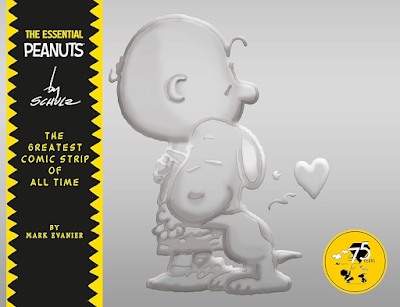
I had a busy fun weekend.
On Saturday, the Charles M. Schulz Museum launched "The Essential Peanuts," a book-and-more celebrating the 75th anniversary of Schulz's comic strip "Peanuts."
I had nothing to do with the book itself, but it was published by my publisher, Abrams, edited by my editor, Charles Kochman, written by Mark Evanier, designed by the great Chip Kidd, and it includes essays by a lot of cartoonists and other people I happen to know.
Karen and I put up Editor Charlie and Chip in our guest rooms for the weekend, and were very happy that "Mutts" cartoonist Patrick McDonnell and his wife, Karen, had time for a quiet dinner with us on Friday night. There's scant opportunity for a real conversation at these events, so we appreciated getting some quality time with them.
The event at the museum was a sold-out success. It opened with a panel moderated by cartoonist and Schulz Studio editor Lex Fajardo, followed by the biggest book signing I've ever seen, involving 13 people who contributed to the project. Everyone left town Sunday morning, headed to a similar event at the Cartoon Art Museum in San Francisco that afternoon.
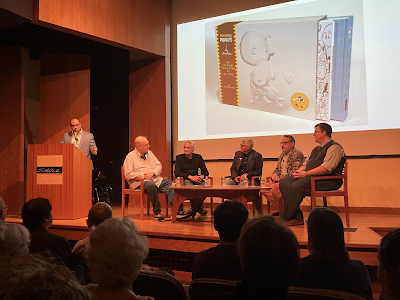 Lex Fajardo introducing the panelists in the Schulz Museum's small theater. From left are writer Mark Evanier, cartoonist Patrick McDonnell, Schulz Studio head and cartoonist Paige Braddock, designer Chip Kidd, and museum curator Benjamin Clark. Many other people who worked on the book were in the audience, but I think the museum was smart to limit this panel to these five. In my experience, a panel that gets much larger just doesn't work (too chaotic, nobody gets time to talk). They put together a different panel for the Cartoon Art Museum event on Sunday, so other contributors did get a chance.
Lex Fajardo introducing the panelists in the Schulz Museum's small theater. From left are writer Mark Evanier, cartoonist Patrick McDonnell, Schulz Studio head and cartoonist Paige Braddock, designer Chip Kidd, and museum curator Benjamin Clark. Many other people who worked on the book were in the audience, but I think the museum was smart to limit this panel to these five. In my experience, a panel that gets much larger just doesn't work (too chaotic, nobody gets time to talk). They put together a different panel for the Cartoon Art Museum event on Sunday, so other contributors did get a chance.
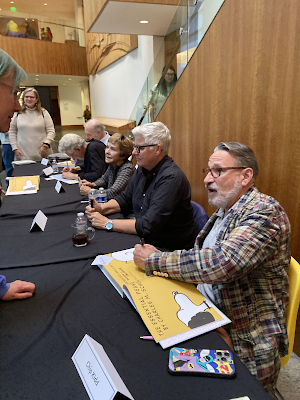 After the panel, the museum lined up all available contributors in its main Great Hall for a mass book signing. From background to foreground are Mark Evanier, Patrick McDonnell, Jean Schulz, Paige Braddock, and Chip Kidd.
After the panel, the museum lined up all available contributors in its main Great Hall for a mass book signing. From background to foreground are Mark Evanier, Patrick McDonnell, Jean Schulz, Paige Braddock, and Chip Kidd. 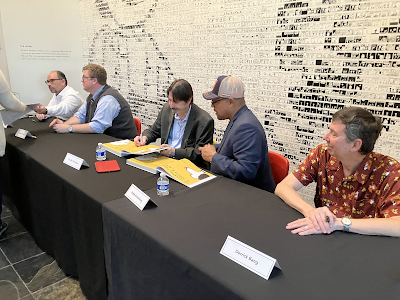 Then you turned to the next table for signatures from Lex Fajardo, Benjamin Clark, Charlie Kochman, "Jump Start" cartoonist Robb Armstrong (my first time meeting him!), and writer Derrick Bang.
Then you turned to the next table for signatures from Lex Fajardo, Benjamin Clark, Charlie Kochman, "Jump Start" cartoonist Robb Armstrong (my first time meeting him!), and writer Derrick Bang.  Then the next table held cartoon director Rob Boutilier, composer Jeff Morrow, and "Rhymes with Orange" cartoonist Hilary Price.
Then the next table held cartoon director Rob Boutilier, composer Jeff Morrow, and "Rhymes with Orange" cartoonist Hilary Price. Just a word about the book itself: it's terrific! The meat of it is a comprehensive overview of "Peanuts" organized by decade, built around the conceit of listing 75 "essential" comic strips plus many others that developed those themes or were otherwise especially memorable. Some "essentials" were no-brainers--the first time we can read Snoopy's thoughts, the first appearance of Woodstock, the first mention of the Great Pumpkin--while others were more nuanced. I probably would have come up with a slightly different list myself but can't argue with any of theirs, and that's the fun of it.
In addition, the slipcase includes a pack of extras, including stickers, postcards, and a reprinting of an early "Peanuts" comic book. It's a nifty package that would make a great gift for any "Peanuts" fan.
 It was a treat to run into Art Roche, a cartoonist and friend who works for the Schulz Studio. Art used to live in Santa Rosa, Calif., where the studio is located, but a few years ago moved to Georgia, so we haven't touched base in real life in quite a while. Great to catch up!
It was a treat to run into Art Roche, a cartoonist and friend who works for the Schulz Studio. Art used to live in Santa Rosa, Calif., where the studio is located, but a few years ago moved to Georgia, so we haven't touched base in real life in quite a while. Great to catch up! 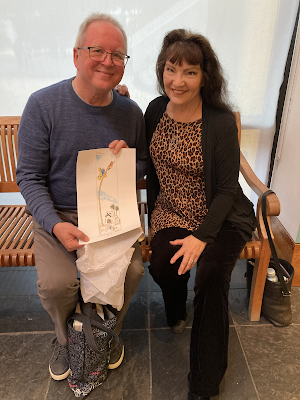 Another treat was meeting actor Brinke Stevens, who came as Mark Evanier's guest. Brinke was once the wife of the late Dave Stevens, the great cartoonist who created "The Rocketeer" and died of leukemia at a much-too-young age. I had never met Brinke but I had a heads-up that she would be there, so I made a print of the Rocketeer artwork I drew for the Cartoon Art Museum's recent exhibition and charity auction in tribute to Dave, gave it to her, and had a nice conversation. Dave based the look of the Rocketeer's girlfriend Betty on '50s pin-up model Bettie Page but Brinke was his life model for the character, so it was great fun for me to give her a drawing that had a rendering of herself in it.
Another treat was meeting actor Brinke Stevens, who came as Mark Evanier's guest. Brinke was once the wife of the late Dave Stevens, the great cartoonist who created "The Rocketeer" and died of leukemia at a much-too-young age. I had never met Brinke but I had a heads-up that she would be there, so I made a print of the Rocketeer artwork I drew for the Cartoon Art Museum's recent exhibition and charity auction in tribute to Dave, gave it to her, and had a nice conversation. Dave based the look of the Rocketeer's girlfriend Betty on '50s pin-up model Bettie Page but Brinke was his life model for the character, so it was great fun for me to give her a drawing that had a rendering of herself in it.  Sunday morning I dropped Charlie and Chip off at the museum to rendezvous with Patrick and his wife Karen (who took this photo) for their trip to San Francisco. An unforgettable weekend!
Sunday morning I dropped Charlie and Chip off at the museum to rendezvous with Patrick and his wife Karen (who took this photo) for their trip to San Francisco. An unforgettable weekend!
November 11, 2025
250 Words on Mom's Home Cooking

[I try to start my day writing 250 words on anything. I’ll post one every Tuesday until I run out of good ones.]
I was an adult before I realized my dear mother was not always a terrific cook.
When I was young, she was a single working woman in her twenties with a full-time job, two feral children, and little money. I can't imagine the crushing responsibility, and have enormous admiration for what she accomplished in those days. However, haute cuisine was not among her accomplishments.
Typical fare: a bologna roll—a tube of pink meat goo tied into a ring—that Mom boiled in water, sliced, and served with catsup. Canned spinach on the side, sprinkled with vinegar. That was dinner.
Another regular meal was frozen cheese pizza doctored up with a tin of anchovies. I can’t explain the anchovies except that Mom always loved them. They were a great treat! To this day, my sisters and I are the only people I know who like anchovies on pizza.
We ate breakfast for dinner: pancakes, eggs, cereal. A lot of fast food: McDonald’s, A&W, Dairy Queen, Pronto Pup corn dogs.
We loved all of it, but now I wonder if Mom felt bad because that was the best she could do for us. More likely, she was grateful to fill our bellies so cheaply and easily.
When I was a teenager, around the time my much younger second sister was born, Mom took cooking classes and got legitimately good. Her sauce-stained recipes remain in the family and bring back many happy culinary memories. But occasionally I miss eating pancakes for dinner.
* * *
PLEASE SUBSCRIBE! I am sharing these little "250 Words On" essays via Substack, which will email a new one to your In Box every Tuesday morning. Just follow this link and enter your email address. It's free, and I promise to never use your address for evil purposes.
November 4, 2025
250 Words on Analog Art

[I try to start my day writing 250 words on anything. I’ll post one every Tuesday until I run out of good ones.]
Some cave paintings in Spain may be 64,000 years old. The earliest decorated pottery was made in China and Japan around 18,000 BC.
Meanwhile, somewhere right now, an artist is desperately failing to recover a digital image they stored on a balky computer drive in 2007.
I treasure original art—both cartoons, which are my professional interest, and more generally all of it. It was in the artist’s studio. They touched it. You can see their preliminary layers, study their decisions, grasp their process and mind. I’ve seen fingerprints in 2000-year-old paint. It makes an intimate connection that crosses centuries.
More and more of my cartooning colleagues have transitioned to digital art. They compose on a Cintiq or iPad using programs like Clip Studio or Procreate. I understand. The ease and speed are seductive; so is the “Undo” button.
I’ll always cartoon with ink on paper. Not that I’m right and they’re wrong. Whatever gets the job done. But I mourn what’s lost.
It’s a broader issue. Historians can research the American Revolution or Civil War by reading period diaries and newspapers. Old ads and posters are a treasure trove. Those media are nearing extinction. In a hundred years, nobody will be able to decode a PDF or JPG. Future historians will see the art and culture of the early 21st century vanish into a black hole.
Even if digital copies survive, the tangible connection between artist and audience will be gone. No fingerprints. It will be a profound shame.
* * *
PLEASE SUBSCRIBE! I am sharing these little "250 Words On" essays via Substack, which will email a new one to your In Box every Tuesday morning. Just follow this link and enter your email address. It's free, and I promise to never use your address for evil purposes.
October 28, 2025
250 Words on Space Time Capsules

[I try to start my day writing 250 words on anything. I’ll post one every Tuesday until I run out of good ones.]
Following up my recent piece on time capsules, the most audacious time capsules ever are those attached to four spacecraft that have left our Solar System and are headed to the stars.
The mission of Pioneer 10 and 11, and Voyager 1 and 2, was to explore the outer planets. Launched in the 1970s, each was a historic triumph. Until they flew past Jupiter, Saturn, Uranus and Neptune, our only views of those distant worlds were blurry photos through Earth-bound telescopes.
Astronomer Carl Sagan convinced NASA to put messages in those far-flung bottles. Each Pioneer has a gold-coated plaque illustrating where the spacecraft came from and what humans look like. The Voyagers carry a gold-plated record (and stylus!) which, if aliens figure out how to use it, will play images and sounds from Earth.
Each could soar for billions of years, surely long after humanity and perhaps Earth itself are gone, before anyone recovers them—assuming there’s anyone out there at all. Our civilization’s last artifacts.
I love and admire the effort, but I might have taken a different approach.
Keeping in mind that weight on a spacecraft is at a premium, I’d have sent two specimens: a fruit fly and a sesame seed, perfectly preserved in the frozen vacuum of space. Their chemical composition, cellular structure, genes and DNA would tell aliens nearly everything about life on Earth, because we are certainly more closely related to fruit flies and sesame seeds than we are to whatever would find them.
* * *
PLEASE SUBSCRIBE! I am sharing these little "250 Words On" essays via Substack, which will email a new one to your In Box every Tuesday morning. Just follow this link and enter your email address. It's free, and I promise to never use your address for evil purposes.
October 24, 2025
The East Wing
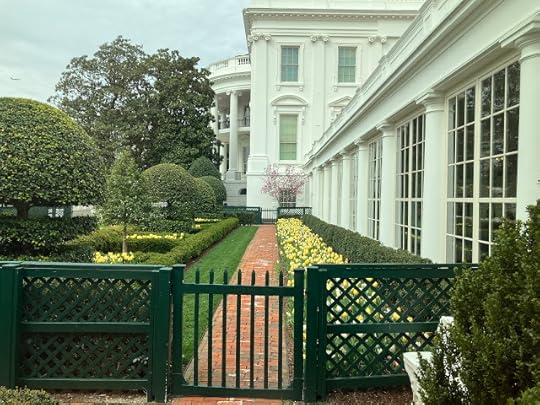 The colonnade at right attached the East Wing to the main White House structure, center. The grass and bushes at left were part of the Jacqueline Kennedy Garden, now also gone.
The colonnade at right attached the East Wing to the main White House structure, center. The grass and bushes at left were part of the Jacqueline Kennedy Garden, now also gone.Karen and I vacationed in Washington, DC in March 2024. She had been there before but I never had, and I joked that I'd better see it before MAGA Republicans tore it all down.
I didn't mean it literally.
One morning we toured the White House, which was a big deal for me. It's a sacred civic space, like a secular church or museum. The People's House. Tourists entered through the East Wing Visitors' Center, which isn't there anymore.
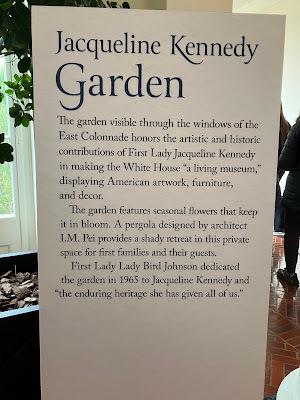 A sign inside the colonnade explained what you were looking at through the windows.
A sign inside the colonnade explained what you were looking at through the windows. Karen and other visitors inside the colonnade leading to the White House. This was a visitor's introduction to the history of the place, setting the context for the more structured self-guided tour to follow.
Karen and other visitors inside the colonnade leading to the White House. This was a visitor's introduction to the history of the place, setting the context for the more structured self-guided tour to follow.I took a few photos; wish I'd taken more, but at the time I had no inkling it would all be gone a year and a half later, illegally bulldozed to satisfy a stupid president's petty ego. Trump has committed worse crimes, but this one hurts.
October 21, 2025
250 Words on Old-Time Radio

[I try to start my day writing 250 words on anything. I’ll post one every Tuesday until I run out of good ones.]
I spent most of my teenage years immersed in a radical outsider artform: AM radio.
Every weeknight from 8 to 11 p.m., San Francisco station KSFO played one hour of radio dramas, one hour of vintage comedy shows, and one hour of tracks from comedy albums. The Shadow, Suspense, Dragnet; Fred Allen, Jack Benny, Burns and Allen; Tom Lehrer, Firesign Theater, Bob Newhart.
My gosh, it was wonderful!
And my gosh, what a nerd I was.
In addition to being tremendously entertaining, the programs gave me great respect for creative artists of the past. Radio performers were toying with their medium—breaking the fourth wall, directly addressing the audience, parodying commercials and newscasts, doing callbacks that rewarded long-time listeners who paid close attention—in very clever ways. The “theater of imagination” conjured more comedy and terror than film could ever depict.
In my field of comics, too many cartoonists don’t know their own medium’s history. Creators such as Winsor McCay, Cliff Sterrett, and George Herriman were doing work a century ago that would be heralded as graphic and storytelling genius if it were published as new today. It holds up. They still have much to teach anyone willing to learn.
“Everything old is new again.”
Disc jockey John Gilliland hosted KSFO’s programs and did a lovely job cultivating a community of listeners in the night. We were all out there, in our bedrooms or cars or with a transistor radio earpiece in our ear, thrilling and laughing, alone but together.
* * *
PLEASE SUBSCRIBE! I am sharing these little "250 Words On" essays via Substack, which will email a new one to your In Box every Tuesday morning. Just follow this link and enter your email address. It's free, and I promise to never use your address for evil purposes.
October 20, 2025
Juanita's Recipe
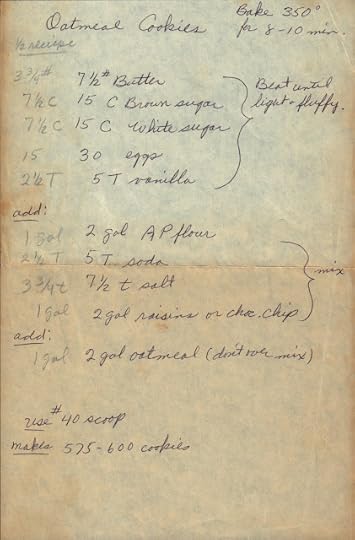
Anyone need cookies for 600?
My late mother-in-law, Juanita, spent her career as a lunch lady for a middle school (lunch ladies don't have to be ladies, but that's what she called her job and the alliteration is too good to pass up). Yesterday my wife, Karen, and her sister, Cathy, unpacked their mom's recipe notebook, which Cathy saved from being trashed.
I love this recipe for three reasons: first is the absurdity of scale, which starts with 7.5 pounds of butter and 30 eggs, and only escalates. Second is that it is written in her hand and stained with the residue of years of honest cooking. Third is that it hearkens to a time when school cafeterias actually cooked for students instead of reheating prepackaged glop and nuggets.
Anyway, if you want to make 600 oatmeal cookies and have two gallons of oatmeal on hand, please enjoy, courtesy of Juanita.
 Juanita!
Juanita!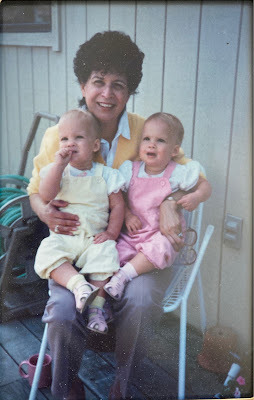 Grandmother with my girls, quite a while ago.
Grandmother with my girls, quite a while ago.
October 18, 2025
No Kings 2025
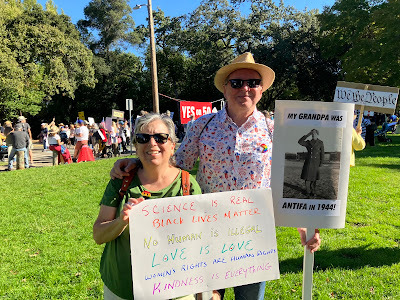 Gathered in the grass of Doyle Park at the end of the route.
Gathered in the grass of Doyle Park at the end of the route.Made a little good trouble today. Karen, our daughters, our niece Claire and I marched a couple of miles in Santa Rosa, Calif. with a lot of other people in support of freedom, democracy, rule of law, American ideals, and basic human decency.
There were two marches that began in different places and then converged to continue as one toward a large park. Crowd size is impossible to estimate when you're in it, but I've been in local demonstrations that had 5000 to 6000 and this felt larger. Indivisible Sonoma County, which helped organize the event, claims 10,000. All I know is that we overheard stunned local cops saying that it was WAY more people than they expected.
 Shark and Penguin showed up. I complimented the Penguin because whoever was in there could only walk in a very small shuffle and kept it up for a couple of miles.
Shark and Penguin showed up. I complimented the Penguin because whoever was in there could only walk in a very small shuffle and kept it up for a couple of miles. I took this photo of our march as we rounded a corner. This march was soon joined by another one just about as large.
I took this photo of our march as we rounded a corner. This march was soon joined by another one just about as large.Participants were in great spirits, volunteers in yellow vests kept everything orderly, cops were smiling and managed traffic in our favor. We ran into many friends, whom I won't name in case they'd rather I didn't.
Speaking of which: I've seen advice online and in print about not letting the authorities identify you at events like this. Wear a mask, don't carry your phone, don't drive your car, don't post on social media. I disagree completely.
I want them to know who I am. Read my posts, put me on the enemies list. I'd be proud. Any time wasted on a white, male, middle-class, squeaky-clean citizen means less time for hassling someone who isn’t all those things.
A video that captures some, but not all, of the extent of our march. That's a lot of good people.
EDITED TO ADD some aerial photos taken by our local Indivisible group. My family is down there somewhere!
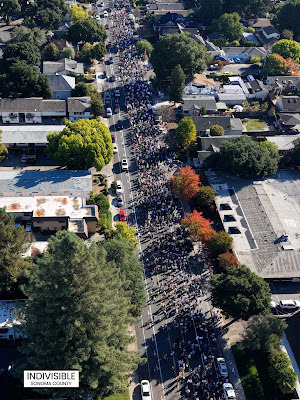


October 14, 2025
250 Words on Time Capsules

[I try to start my day writing 250 words on anything. I’ll post one every Tuesday until I run out of good ones.]
Somewhere in a backyard in Rapid City, South Dakota is a jelly jar I buried when I was 7 years old. I don’t remember what’s in it, but I bet I could put a shovel in the ground within a foot of it.
I love time capsules. There’s something deeply romantic about leaving a message to the future. A note in a bottle. A nibble of immortality, the hope that anyone will care. “We were here, this was important to us.”
In reality, most time capsules turn out to be disappointments. Those that haven’t been destroyed by water leaks are filled with the most boring antiques imaginable. Coins, proclamations, minutes from a board meeting. Never a singing frog. You could find half the artifacts in better condition at a flea market.
Two famous ones are the Westinghouse Time Capsule, entombed during the 1939 World’s Fair to be opened in the year 6939, and the Crypt of Civilization, sealed inside a former swimming pool at Oglethorpe University in 1940, to be opened in 8113. Both are worth a Web search. I appreciate their creators’ cockeyed optimism.
Hidden in my rebuilt house, inaccessible but protected from the elements, is a signed copy of A Fire Story with a little note and drawing. I like to imagine that whoever finds it, whenever they find it, will take the time to read it and reflect on the life and times of the guy who stashed it. I was here. This was important to me.
* * *
PLEASE SUBSCRIBE! I am sharing these little "250 Words On" essays via Substack, which will email a new one to your In Box every Tuesday morning. Just follow this link and enter your email address. It's free, and I promise to never use your address for evil purposes.
Brian Fies's Blog
- Brian Fies's profile
- 64 followers



